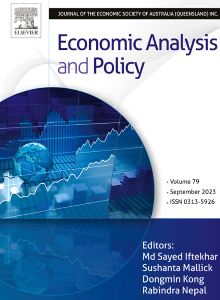中国劳动密集型制造业出口弹性及其维度细分评估
IF 8.7
2区 经济学
Q1 ECONOMICS
引用次数: 0
摘要
在全球不确定性加剧的时代,劳动密集型制造业的出口弹性不仅对缓冲外部冲击至关重要,而且对维持国际贸易和就业的稳定也至关重要。本研究通过考察中国劳动密集型制造业在全球金融危机和新冠肺炎大流行这两大危机期间的时空动态,建立了一个评估出口弹性的分析框架。然后从三个不同的维度系统地分析出口弹性:阻力、恢复和更新。实证结果表明,中国劳动密集型制造业在两次危机中都表现出波动的弹性轨迹,没有过渡到新的稳定增长路径。环境污染程度较高的行业的出口弹性一直较弱。此外,与全球金融危机期间相比,在2019冠状病毒病大流行期间,这些行业出口弹性的空间相互依赖性有所下降。值得注意的是,在全球金融危机期间,与整个制造业相比,劳动密集型制造业表现出相对较弱的抵抗和更新能力,但较强的恢复能力。此外,在2019冠状病毒病大流行期间,劳动强度较高的行业普遍表现出较低的出口阻力。这些见解极大地促进了我们对出口行业如何适应各种经济中断的理解,从而为更有针对性和更有效的政策干预提供信息。本文章由计算机程序翻译,如有差异,请以英文原文为准。
Assessing export resilience and its dimensional subdivision in China's labor-intensive manufacturing industry
In an era marked by heightened global uncertainty, export resilience in the labor-intensive manufacturing industry has become critical not only for cushioning external shocks but also for sustaining stability in international trade and employment. This study establishes an analytical framework to assess export resilience by examining the spatiotemporal dynamics of China’s labor-intensive manufacturing during two prominent crises: the Global Financial Crisis (GFC) and the COVID-19 pandemic. Export resilience is then systematically analyzed across three distinct dimensions: resistance, recovery, and renewal. The empirical findings reveal that China's labor-intensive manufacturing industries exhibited fluctuating resilience trajectories without transitioning into a new stable growth path during both crises. Industries characterized by higher levels of environmental pollution consistently displayed weaker export resilience. Moreover, the spatial interdependencies of export resilience within these industries declined during the COVID-19 pandemic compared to the GFC. Notably, during the GFC, labor-intensive manufacturing exhibited relatively weaker resistance and renewal capacities but stronger recovery abilities compared to the overall manufacturing sector. Furthermore, industries characterized by higher labor intensity generally demonstrated lower levels of export resistance during the COVID-19 pandemic. These insights significantly advance our understanding of how export industries adapt to diverse economic disruptions, thereby informing more targeted and effective policy interventions.
求助全文
通过发布文献求助,成功后即可免费获取论文全文。
去求助
来源期刊

Economic Analysis and Policy
ECONOMICS-
CiteScore
9.80
自引率
9.20%
发文量
231
审稿时长
93 days
期刊介绍:
Economic Analysis and Policy (established 1970) publishes articles from all branches of economics with a particular focus on research, theoretical and applied, which has strong policy relevance. The journal also publishes survey articles and empirical replications on key policy issues. Authors are expected to highlight the main insights in a non-technical introduction and in the conclusion.
 求助内容:
求助内容: 应助结果提醒方式:
应助结果提醒方式:


